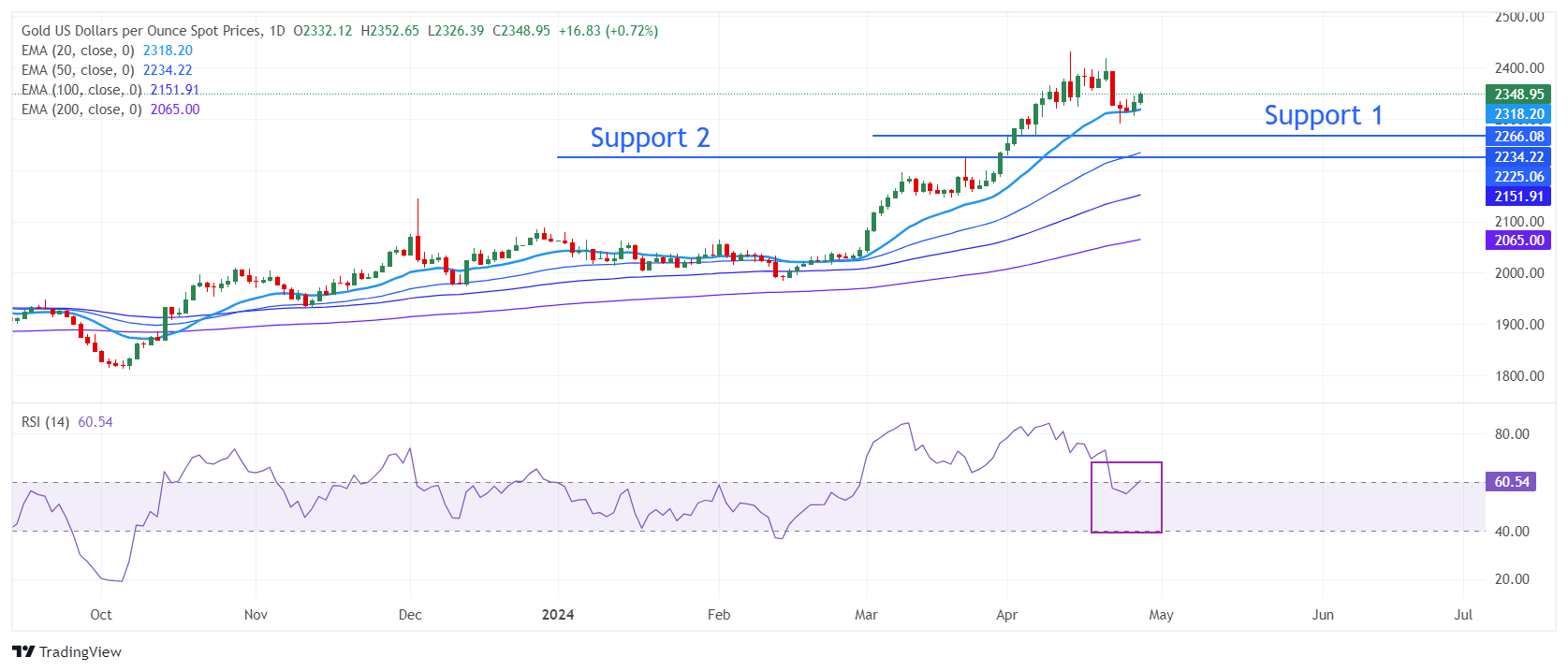- Gold price faces selling pressure near $2,350 as the US Dollar rebounds.
- Higher-than-expected US Core PCE data has boosted the US Dollar's recovery.
- Expectations that the Fed will delay rate cuts remain strong in the markets.
Gold price (XAU/USD) falls from $2,350 in Friday's New York session as US annual underlying Personal Consumption Expenditure (PCE) Price Index data for March came in higher than the expected. The annual core inflation figure rose at a rate of 2.8%, compared to estimates of 2.6%.
These higher-than-expected figures are expected to weaken Gold's appeal as they would ease hopes of Federal Reserve (Fed) rate cuts at the September monetary policy meeting. The monthly core inflation data grew in line with expectations and the previous reading of 0.3%. This scenario bodes well for bond yields and the US Dollar.
The US 10-year bond yield has fallen slightly to 4.69%, but remains near its highest level in five months. Yields remain firm as the stagnation in inflation's decline to the 2% target will bolster prospects of the Fed delaying rate cuts until later this year.
Meanwhile, the US Dollar Index (DXY), which tracks the value of the dollar against six major currencies, bounces to 105.80 following better-than-expected inflation data. The US dollar fell on Thursday after weak US GDP growth in the first quarter raised doubts about the economy's ability to maintain its strength in the coming quarters.
Daily summary of market developments: Gold price under pressure and US dollar rebounds
- Gold price struggles to hold near 2,350 while US Dollar bounces after March US PCE inflation data.
- Previously, the US dollar had suffered the consequences of a lower than expected growth rate of the US economy in the first quarter. The US economy grew at an annualized rate of 1.6%, below the consensus of 2.5% and the previous reading of 3.4%. This has raised concerns about the outlook for the US economy.
- In general, a sharp decline in GDP growth could be the result of one or more factors, such as weak household spending, limited monetary stimulus, or lower government spending. In theory, lower-than-expected GDP growth should have boosted expectations that the Federal Reserve (Fed) would reverse its restrictive monetary policy, which it has maintained since strong stimuli due to the COVID-19 pandemic raised pressures. inflationary at historical levels.
- Traders continue to trim their bets on a Fed rate cut as GDP and Core Consumer Price Index (PCE) data come in ahead of expectations. The GDP price index rose to 3.1% from 1.7% previously. CME's Fedwatch tool shows there is a 59% chance of a rate cut in September, down from 69% a week ago.
Technical Analysis: Gold Price Faces Pressure Near $2,350

Gold price rebounds after discovering buying interest near the 20-day EMA, which is trading around $2,315. The short-term and long-term appeal remains strong as the short-term and long-term exponential moving averages (EMAs) are sloping upwards.
On the downside, the three-week low near $2,265 and the March 21 high at $2,223 will be the main support areas for the price of Gold.
The 14-period RSI falls below 60.00, suggesting that the bullish momentum has come to an end, at least for now. However, the long-term bullish bias is intact as long as the RSI remains above 40.00.
Frequently asked questions about Gold
Why invest in Gold?
Gold has played a fundamental role in human history, as it has been widely used as a store of value and medium of exchange. Today, apart from its brilliance and use for jewelry, the precious metal is considered a safe haven asset, meaning it is considered a good investment in turbulent times. Gold is also considered a hedge against inflation and currency depreciation, since it does not depend on any specific issuer or government.
Who buys more Gold?
Central banks are the largest holders of Gold. In their aim to support their currencies in turbulent times, central banks tend to diversify their reserves and purchase Gold to improve the perception of strength of the economy and currency. High Gold reserves can be a source of confidence for the solvency of a country. Central banks added 1,136 tons of gold worth about $70 billion to their reserves in 2022, according to data from the World Gold Council. This is the largest annual purchase since records exist. Central banks in emerging economies such as China, India and Türkiye are rapidly increasing their gold reserves.
What correlation does Gold have with other assets?
Gold has an inverse correlation with the US Dollar and US Treasuries, which are the main reserve and safe haven assets. When the Dollar depreciates, the price of Gold tends to rise, allowing investors and central banks to diversify their assets in turbulent times. Gold is also inversely correlated with risk assets. A rally in the stock market tends to weaken the price of Gold, while sell-offs in riskier markets tend to favor the precious metal.
What does the price of Gold depend on?
The price of Gold can move due to a wide range of factors. Geopolitical instability or fear of a deep recession can cause the price of Gold to rise rapidly due to its status as a safe haven asset. As a non-yielding asset, the price of Gold tends to rise when interest rates fall, while rising money prices tend to weigh down the yellow metal. Still, most of the moves depend on how the US Dollar (USD) performs, as the asset is traded in dollars (XAU/USD). A strong Dollar tends to keep the price of Gold in check, while a weaker Dollar is likely to push up Gold prices.
Source: Fx Street
I am Joshua Winder, a senior-level journalist and editor at World Stock Market. I specialize in covering news related to the stock market and economic trends. With more than 8 years of experience in this field, I have become an expert in financial reporting.







